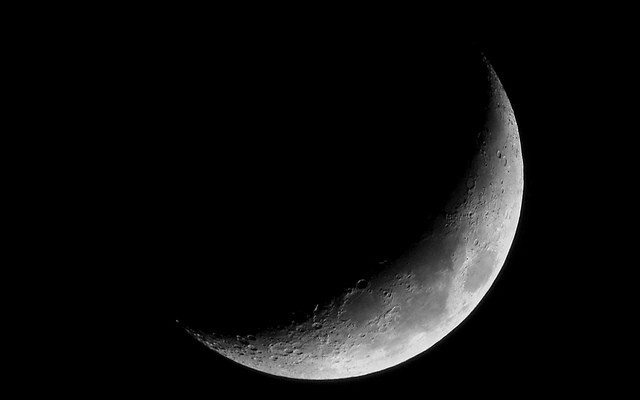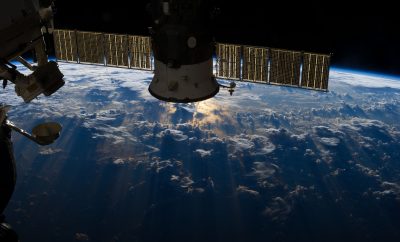 Image courtesy of [Bart van Leeuwen via Flickr]
Image courtesy of [Bart van Leeuwen via Flickr]
Health & Science
Who Owns the Moon? Space Property Rights Are Nearing
On July 20, 1969, man set foot on the moon for the first time in what Neil Armstrong famously called “one small step for a man, one giant leap for mankind.” After these first dusty steps, people pondered what giant leaps might be next, dreaming about lunar colonies, outer space tourism, and most recently, space mining.
Read More: Thanks to New Discovery Your Seat on Mars One is Looking Good
Recent unmanned moon expeditions detected a bounty of 1.6 billion tons of water ice and other rare earth elements (REE) lingering beneath the moon’s surface. Combine this enticing bounty with speedily developing technologies that make space travel more accessible and you’ve got a budding space mining industry. Space exploration technology has become infinitely cheaper, better, and smaller than it was back in 1969, pushing what was once only possible for national governments into the hands of private companies gearing up to tap into outer space resources
But one little hitch might hold them back. The only acknowledged international regulation on space travel, the Outer Space Treaty of 1967, left space property rights ambiguous. Companies and nations seem free to embark on all manner of expeditions, but the treaty doesn’t mention if they legally own any resources they pick up on the way. With hefty investments behind their ventures, space-faring companies demand assurance that they’ll be able to profit from the resources they might collect.
Will an old agreement keep businesses from capturing the teeming resources space has to offer?
Businesses With Extra-Terrestrial Aspirations
Lunar mining? Piece of cake. Tapping into outer space resources has officially graduated from being a remote possibility to a reality. Already many commercial companies are wooing investors and toiling over in-depth plans, all gearing up to get a piece of the space pie.
- The Shackleton Energy Company (SEC) plans to build the first space fueling station. Remember that 1.6 billion tons of water ice just waiting on the moon? When converted to liquid form, the hydrogen and oxygen in this ice creates a powerful chemical propellent–the most powerful we know of. Liquid hydrogen and liquid oxygen already power most space shuttle engines. SEC plans to mine the moon’s ice and set up a fuel station in Earth’s orbit. Fueling from this location instead of Earth could decrease costs by a factor of up to 20 to one.
- Moon Express developed a revolutionary vehicle, the MX-1 lunar lander, powered by sunlight and fueled by hydrogen peroxide. It will send the craft on speculating missions to investigate resources that might be mined. This company plans to perfect the safety and efficiency of lunar landings, making the moon as accessible as an eighth continent.
- Planetary Resources fixed its eye on asteroids, the most abundant sources of water that can be converted into hydrogen and oxygen rocket fuel. The company uses an algorithm to find asteroids and determine which ones might be resource rich.
- The Google Lunar X Competition offers incentives for discoveries that make getting to the moon easier and cheaper. Teams hoping to snag the $30 million grand prize have to land a robot on the moon, move it around, and send back HD Mooncasts for earth-dwellers. The competition is well under way and will wrap up in December 2016. Teams have already innovated promising robots, including this animated prototype rover named Uni from Team AngelicvM featured in the short video below.
Despite dazzling technology and high hopes, unclear space property laws pose major risks for commercial companies. Space travel costs have decreased relative to 1960s costs, but it’s still not cheap. Certainly not cheap enough that companies will launch rockets without solid assurance that they’ll own whatever resources they find on their missions. As you can see, these companies listed above, as well as many others, are ready to go. Let’s see what’s holding them back.
The Outer Space Treaty of 1967
The Outer Space Treaty of 1967 stands as the only cooperative international agreement governing space travel. The treaty clearly forbids countries from declaring sovereignty over celestial bodies in Article II:
Outer space, including the Moon and other celestial bodies, is not subject to national appropriation by claim of sovereignty, by means of use or occupation, or by any other means.
Mining isn’t specifically mentioned, but then again mining the moon was an outlandish possibility in 1967. The provision stood to bar nations from lassoing the moon, so to speak. Now as we look to extract resources from these common areas, many desire explicit, legal guarantees that they may do so–both for financial reassurance and to avoid conflict with other nations and companies wrestling over the same resources. Established property rights would provide the certainty necessary to encourage cultivating outer space for abundant natural resources.
Read More: FAA Allowing Companies to Call Dibs on the Moon
One company, Bigelow Aerospace, pushes adamantly for clarification on real property rights in space. In an internal report issued to NASA, Robert Bigelow, founder and president of the company, summarizes its desires well:
Without property rights, any plan to engage the private sector in long-term beyond LEO activities will ultimately fail. Companies and their financial backers must know that they will be able to enjoy the fruits of their labor relative to activities conducted on the Moon or other celestial bodies, and own the property that they have surveyed, developed, and are realistically able to utilize.
Who bears the burden of deciding the fate of Bigelow Aerospace and other hopeful companies? Article 6 of the Outer Space Treaty of 1967 specifies that governments bear responsibility for the activities of their nation and subjects in outer space, including the decision to authorize activities. Many U.S. government entities have a say in space happenings, but it’s the Federal Aviation Administration’s Office of Commercial Space Transportation (FAA-AST) and its advisory committee, the U.S. Commercial Space Transportation Advisory Committee (COMSTAC), that bears the burden of responding to recent requests to clarify commercial space laws.
During the most recent FAA-AST meeting in September 2014, Ken Hodgkins, Director of the Office of Space and Advanced Technology, acknowledged the number of private companies planning commercial ventures and how their activities question the legal frameworks around space exploration. He stressed balancing investment incentives with U.S. foreign policy obligations. Hodgkins stated concerns about proposed commercial activity falling in line with the Outer Space Treaty and encouraged further dialogue between private companies and U.S. agencies. He does not believe attempts at changing the treaty would result in faster resolution of the questions and assured meeting attendees that they are working with foreign nations to discuss the provisions in question.
Past Space Property Challenges
Very few cases have tested the limits of the Outer Space Treaty, so its enforceable interpretations remain unclear. However, a few incidents might influence the direction of space property rights decisions.
In one space property court case, Nemitz v. United States, a San Francisco district court ruled against a man’s claim of ownership on the asteroid 433, also known as Eros. Nemitz had filed a claim of ownership on the asteroid through a now-unpublished online database known as the Archimedes Institute. When NASA landed on his asteroid in 2001, Nemitz attempted to charge them parking fees. When they rejected him, he took his claim to court, where judges also dismissed his claim, stating that his assertion of ownership had no ground in law.
In a more powerful non-court precedent, moon materials from the Apollo landings in the 1960s have already been traded and sold. NASA traded lunar samples with the Soviet Union in exchange for their samples from robotic moon missions. Private individuals in Russia have even sold samples. These transactions imply outerspace materials can be owned, traded, and sold, giving hope to mining hopefuls.
New Space Legislation
Representative Bill Posey (R-FL) introduced H.R.1508 on March 15, 2015,
To promote the development of a United States commercial space resource exploration and utilization industry and to increase the exploration and utilization of resources in outer space
A more in-depth summary is not yet available, but you can be certain the measure will tackle legal barriers barring exploration of space resources. The bill now stands with the House Committee on Science, Space, and Technology.
Last month the House passed the National Aeronautics and Space Administration Authorization Act of 2015, a near repeat of the National Aeronautics and Space Administration Authorization Act of 2014, which died in the Senate. The act authorizes NASA activities like space exploration, research, and education. While the bill doesn’t expressly cover commercial enterprise and space property rights, the sentiment of encouraging space-related innovation will serve commercial interests well.
Where no man has gone before…
As we speak, dreams of space colonies, moon mining, and even landing on Mars come closer to reality. This pulls legal questions and concerns to the surface, but only because we plan to go where no man has gone before. Establishing procedures will take time, cooperation, and patience, but it will be worth it to tackle our final frontier.
Resources
Primary
Federal Aviation Administration: Commercial Space Transportation Advisory Committee
U.S. Congress: Summary: H.R.810 — 114th Congress (2015-2016)
U.S. Congress: Summary: H.R. 1508 — 114th Congress (2015-2016)
United Nations Office for Outer Space Affairs: United Nations Treaties and Principles On Outer Space
Additional
Institute of Physics: Mining the Moon Becomes a Serious Prospect
Space.com: Mining the Moon? Space Property Rights Still Unclear
Washington Post: Looking for an Exotic Vacation? Here’s Why Moon Travel May Be Only 20 Years Away
Space.com: Moon Mining Idea Digs Up Lunar Legal Issues
Space Future: Real Property Rights in Outer Space
Wired: Space Law: Is Asteroid Mining Legal?
NASA Space Flight: Moon Property Rights Would Help Create Lunar Industry
Space Policy Online: Legislative Checklist 114h Congress: Major Space Related Legislation
Space Foundation: U.S. Government Space Programs
Space Policy online: House Passes 2015 NASA Authorization Bill








Comments